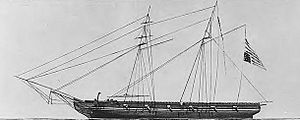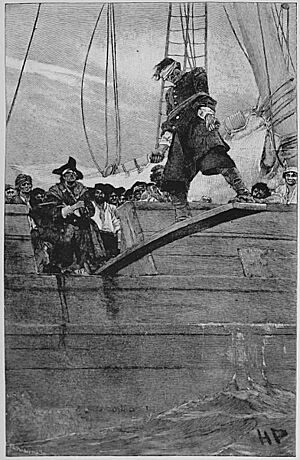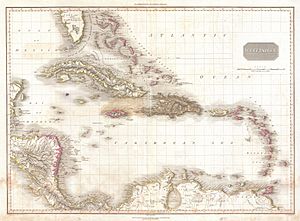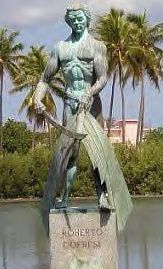West Indies anti-piracy operations of the United States facts for kids
Quick facts for kids West Indies anti-piracy operations |
|||||||
|---|---|---|---|---|---|---|---|
| Part of Piracy in the Caribbean | |||||||
 USS Grampus defeated the pirate ships Palyrma and El Mosquito during the operation. |
|||||||
|
|||||||
| Belligerents | |||||||
| Commanders and leaders | |||||||
| William H. Crawford James Biddle David Porter |
Jean Lafitte Jean La Farges Louis-Michel Aury Roberto Cofresi |
||||||
| Strength | |||||||
| 2 frigates 2 corvettes 2 sloops of war 2 brigs 4 schooners 2 gunboats 1,346 sailors and marine infantry |
Unknown | ||||||
The West Indies Anti-Piracy Operations were a time when the United States Navy worked to stop pirates in the Antilles and nearby waters. From 1817 to 1825, the American West Indies Squadron chased pirates by sea and on land. They mostly focused on areas around Cuba and Puerto Rico. After a famous pirate named Roberto Cofresi was captured in 1825, pirate attacks became very rare. This operation was seen as a big success, even though a few small pirate acts happened until the early 1900s.
Contents
Stopping Pirates in the Caribbean
Before 1822, the United States Navy and the U.S. Revenue Marine (which is now the Coast Guard) had already been fighting pirates. They also worked to stop the illegal slave trade in the Caribbean and Gulf of Mexico.
In September 1821, pirates attacked three American merchant ships. This led the U.S. Congress to allow Commodore James Biddle to send a larger fleet to the Caribbean. This fleet included many ships like frigates, corvettes, sloops, brigs, and schooners. It also had two gunboats and more than 1,500 sailors and marines. Before this, only single ships had been sent to deal with pirates.
Over several years, the American West Indies Squadron fought against pirates from different countries. Many times, they sank or captured pirate ships. However, the pirates often managed to escape to shore.
Early Efforts Against Pirates (1817–1821)
After the Spanish American wars of independence, Spain's navy in the Caribbean Sea became weaker. This allowed pirates to become more active along the Gulf Coast. Many of these pirates were from Latin America and sometimes acted as privateers. Privateers were like legal pirates who had permission from a government to attack enemy ships. However, if they attacked American merchant ships, they were seen as pirates.
The Revenue Marine Service Joins the Fight
The Revenue Marine Service, which later became the U.S. Coast Guard, was involved in fighting pirates very early on. In 1793, one of their ships, the Diligence, chased a pirate ship ashore. After this success, revenue cutters were given the job of stopping piracy and protecting America's coasts.
In 1819, two one-gun schooners, USRC Alabama and USRC Louisiana, joined the U.S. Naval fleet. These ships fought important battles against pirates at sea. For example, on August 31, 1819, the cutters Louisiana and Alabama fought the pirate captain Jean Le Farges' ship, the Bravo, off Florida. The crews boarded the enemy ship and captured it after a hand-to-hand fight. Le Farges, who was a lieutenant for the famous pirate Jean Lafitte, was later killed.
On July 19, 1820, the Alabama captured four pirate ships. Later, on November 2, 1822, the Alabama fought pirates again and captured five more ships. These early actions were the start of the anti-piracy mission that the modern U.S. Coast Guard still carries out today.
The first U.S. Navy ships to fight West Indies piracy were the schooners USS Enterprise, USS Nonsuch, and USS Lynx. These ships worked on their own at first. In 1819, President James Monroe sent Commodore Oliver Hazard Perry to Venezuela. His job was to demand that Venezuelan privateers stop attacking American merchant ships. Perry succeeded in getting a treaty signed, but he sadly died of yellow fever on his way back to the United States. This caused the agreement to fail.
By 1820, pirate attacks were increasing. U.S. warships fought in several battles that year, and pirates captured twenty-seven American merchant ships. Between 1818 and 1821, USS Enterprise alone captured thirteen pirate and slave ships.
In October 1821, USS Enterprise helped three merchant ships that had been seized by four pirate boats near Cuba. Sailors from the Enterprise attacked the pirates, killing or capturing over forty of them and taking two of their ships. A month later, Enterprise attacked a pirate base and cleared the area of criminals.
In September 1821, three American merchant ships were attacked violently off Matanzas, Cuba. The crew of one ship was harmed, and the ship was set on fire. Many people on the other two ships were killed, and those ships were also burned. This terrible event was a major reason why the anti-piracy operation continued.
On December 16, 1821, Lieutenant James Ramage on USS Porpoise found five enemy ships, including a merchant brig that had been captured. Forty sailors in five boats attacked the pirates. Many pirates fled to shore, but some fought back. The American boats destroyed the five pirate ships by burning them and freed the captured merchant ship.
More Battles and New Ships (1822–1823)

In 1822, USS Grampus met a brig called Palyrma that was flying Spanish flags. Lieutenant Gregory suspected it was a pirate ship. When Grampus got close, Palyrma opened fire, and a short battle began. The pirates were from Puerto Rico and had a fake document saying they were legal privateers. They were arrested and given to the Spanish in Cuba. At this time, captured pirates were usually handed over to Spain because the U.S. did not have the power to imprison them.
The U.S. Navy could not chase pirates onto Spanish land. So, in April 1822, Commodore David Porter took command of the squadron. He tried to get permission from the governors of Cuba and Puerto Rico to land American troops on their shores. Both governors said no. However, the U.S. government later allowed the West Indies Squadron to land in remote areas.
Commodore Porter then attacked and destroyed a pirate group at Funda Bay, Cuba, in September 1822. On the same day, USS Peacock captured a boat full of pirates. Later, Peacock found a merchant ship that pirates had just attacked. Captain Stephen Cassin sent out boats, which captured four pirate schooners, but most of the pirates escaped.
On November 8, 1822, Lieutenant William Howard Allen of USS Alligator was killed while leading an attack against three enemy schooners. These schooners were holding five merchant ships hostage. In this battle, two of the schooners were captured, and at least fourteen pirates were killed. Because of Lieutenant Allen's death, the Secretary of the Navy allowed Commodore Porter to get new ships for the squadron.
Porter got eight new shallow-draft schooners, five large barges, a steam-powered riverboat, and a supply ship. These new ships helped the squadron chase pirates into shallow waters. The new squadron left the United States for Cuba on February 15, 1823. Commodore Biddle also received new orders: he could now land shore parties in populated areas if he told the locals first. He was also told to work with other navies fighting pirates.
In March 1823, USS Fox was sent to San Juan, Puerto Rico, to get a list of legal privateers. When the Fox entered San Juan Harbor, an artillery battery fired on the ship. A few shots hit the Fox, and her commander, Lieutenant William H. Cocke, was badly wounded and later died. Commodore Porter later accepted an apology for this incident from Puerto Rico's governor.
On April 8, 1823, two barges, USS Gallinipper and USS Mosquito, freed an American merchant ship. The navy sailors killed two pirates and arrested one, though most got away.
On July 5, 1823, USS Sea Gull, along with the barges Gallinipper and Mosquito, fought pirates off Matanzas. They met a heavily armed schooner with about seventy-five pirates. The American ships attacked with their cannons, and the schooner was hit. The pirates panicked and started jumping into the water. The American sailors and marines fired at the fleeing pirates, shouting "Allen, Allen" in memory of their fallen lieutenant. About seventy pirates were killed, and only five survived.
The Final Years of the Operation (1824–1825)
Throughout the operation, tropical diseases were a big problem for the American warships. Many ships had to return to the United States when sailors got sick. By January 1824, most of the West Indies Squadron ships had been called back because of illness.
In February 1825, Commodore Porter was removed from duty and later joined the Mexican Navy. This happened after Spanish authorities in Puerto Rico detained Lieutenant Platt, the commander of USS Peacock, in October 1824. Pirates had raided Saint Thomas and returned to Fajardo with stolen goods. When Lieutenant Platt tried to help the owner get his goods back, he and his men were arrested by the Spanish Army. They were released after Platt showed his uniform and commission.
When Commodore Porter heard about this, he sailed to Fajardo with his ships. He landed a shore party and demanded an apology from the Spanish. The Spanish eventually agreed to make a public apology. However, the U.S. government was not happy with Commodore Porter's actions, and he was court-martialed before he resigned.
The American operation against West Indies pirates was declared a victory in 1825, even though a few pirate attacks continued occasionally.
In March 1825, the Gallinipper joined British ships in an operation against Cuban pirates. American and British forces attacked a pirate schooner, killing eight enemies and capturing nineteen others. The next day, another pirate schooner was captured without a fight.
The ship of the famous pirate Roberto Cofresí, named El Mosquito, was disabled on March 5 by USS Grampus and two Spanish sloops. Cofresí fled inland, where a local person recognized and helped authorities capture him. Cofresí was considered the last successful Caribbean pirate. After he was executed on March 29, 1825, piracy in the region truly declined for good.
The United States naval operations in the West Indies were eventually taken over by other naval squadrons by 1842.



